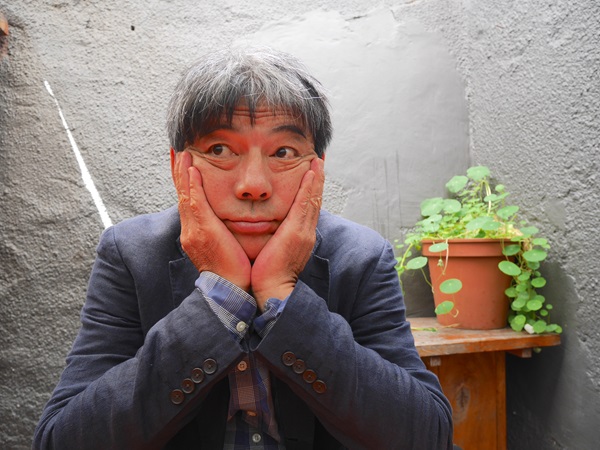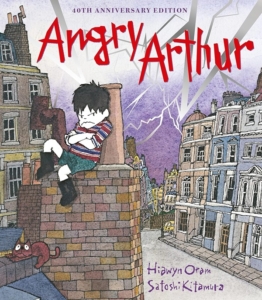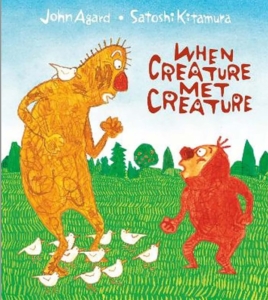
Catching up with Satoshi Kitamura
Satoshi Kitamura’s work is notable for its distinctive, whimsical line-work, warm humour and a charming ability to visualise the depth, scale and turbulence of children’s emotional and creative range and capacities. It covers an impressive range of genres and has embraced numerous influences and approaches. Jake Hope caught up with Satoshi on a recent visit to the UK.
Satoshi’s early reading involved a fascination with comics. ‘There were great comics, which helped to pave the way for modern comics. You would see the stories every week and they had strong storytellers and artists. I often copied the characters and that helped me develop as well as influencing me.’
Contemplating his childhood, Satoshi describes a burgeoning interest in art. ‘I’ve drawn all the time, ever since I was three or four. My older brother was very good at it. He drew and I copied him. I drew a lot in school. We never learnt art; we just did doodles.’
Practising his art in this way helped pave the road to a career in illustration. ‘I started illustrating commercially when I was nineteen. I didn’t mean to be an illustrator. I took a job in advertising which involved illustrations for magazines. I teamed up with a designer and we did a lot of work together.’ Satoshi feels working in commercial illustration helped hone his technique. It also equipped him with an awareness for how to persuade potential clients. ‘There’s a psychological game to it. What I did when I first sent my ideas to publishers was that I had a very short story and I put the story and drawing onto a one-page piece of paper. This meant it was very easy to present and to get a sense of who was interested. With picture books you have to keep your readers interested and engaged in a way that’s similar to commercial illustration.’
Aged twenty-three and wanting to learn English, Satoshi came to England. Whilst here he had an idea for a picture book. ‘I made a small dummy which I sent to publishers. It got good responses.’ Despite this, the book was not published. Satoshi described a reticence that existed in taking a punt on new illustrators at the time. A change came, however, when Satoshi met with Klaus Flugge, the founder of Andersen Press.
‘Klaus gave me a text by Hiawyn Oram.’ This was Angry Arthur. ‘I spent three or four months working with the text, trying to visualise it. Working with Hiawyn, I learnt such a lot about how to write texts and how to tell stories through pictures.’
2022 saw Angry Arthur celebrate its fortieth anniversary. It’s a book whose story and themes endure, a fact Satoshi attributes to its uniqueness and ability to help children to open up about their emotions. ‘Hiawyn writes so concisely and so profoundly.’ The book won the  Mother Goose Award, creating new opportunities for Satoshi. The book was published in new territories and led to new commissions both with Hiawyn Oram and also with Kestrel Books who invited Satoshi to illustrate a collection of Roger McGough’s poetry.
Mother Goose Award, creating new opportunities for Satoshi. The book was published in new territories and led to new commissions both with Hiawyn Oram and also with Kestrel Books who invited Satoshi to illustrate a collection of Roger McGough’s poetry.
Since then, Satoshi has illustrated across a wide range of forms which have included picture books, poetry, non-fiction and even signage for museums. Picture books are his favourite form, but illustrating poetry requires an approach that Satoshi feels he learns from every time. ‘Reading poems make me visualise images. Often these are different to those I usually illustrate and I have to find a way to bring these to being.’
Many of the poems Satoshi has illustrated have been by John Agard. He recently illustrated a picture book text for John, When Creature Met Creature. The book is a celebration of verbal and non-verbal communication. Satoshi describes some of the challenges of working on the book. ‘At first, I saw Creature as more of an animal, but then I felt it should be somewhere between being a human and an animal. I also had to try to visualise the emotional side. It was translated into Japanese by me and won a prize there. It was a difficult book to translate because of the rhymes.’
When Creature Met Creature is one of a number of projects Satoshi and John have worked on together. One of these was The Young Inferno. An ambitious urban retelling of Dante’s Divine Comedy., ‘It was a really interesting project. It was John’s interpretation of Dante.  I really enjoyed it. I drew it very freely. I like the way John seems to be able to think of anything and everything and is very spontaneous.’
I really enjoyed it. I drew it very freely. I like the way John seems to be able to think of anything and everything and is very spontaneous.’
We discuss the differences between when Satoshi is working on his own text or someone else’s. ‘When I’m working on my own, if I have an idea, I draw or write about it in my sketchbook. Sometimes it’s the fragment of an idea, sometimes it erupts into something bigger. It can be a slow process as it takes a long time to develop a fully-fleshed story. One idea doesn’t make a story, it often takes two or three. Looking through old sketchbooks, I sometimes see an idea I had years ago and it accumulates to become a story. All of this happens internally which makes it hard to describe. Once the idea is in place you have to do a lot to find the right setting and characters that match the story. As you work and work upon it, the text gradually becomes smaller and shorter and eventually gets to a stage where it can’t get any shorter without becoming meaningless. That’s when the story is done and the pictures have to be finished.’
Alongside his illustration, Satoshi also works as an artist and sculptor. ‘If I had more time, I would like to do more exhibitions. I like doing sculptures. I enjoy working with timber. This year, in the summer I had an exhibition in Kyoto of paintings and small sculptures. Creating picture books is a full-time job. It doesn’t leave enough time to do other things as much as I would like.’
One of these other things that Satoshi has enjoyed is working on graphic stories for adults. ‘There’s a literature magazine in Japan called Monkey, which features lots of Japanese short stories. I have illustrated for Monkey for many years and have done well over a hundred pages. They are hoping to publish some of these in America. I would like to do more of graphic stories that are suitable for any age.’
Satoshi’s next book is School for Puppies, due out in 2024. ‘It’s a charming book about a girl who goes to school and whose puppy has to wait for the girl to return home. He sees a group of other puppies and chases them, finding his way into a school for puppies.’ The book will publish with Andersen Press.
Satoshi is also working on another book with Scallywag Press about music. It’s a return to a theme that recurs through his work and that influenced The Carnival of Animals and Igor, the Bird who couldn’t Sing. He also has possible plans for another non-fiction title. Satoshi’s creativity and enthusiasm for his art and his ability to find expression for the influences and emotions around him is infectiously inspiring, our conversation concludes far too soon!
Jake Hope is a reading development and children’s book consultant, and chair of the working party for YOTO Carnegies Working Party.
Books mentioned:
Angry Arthur, Hiawyn Oram, illus Satoshi Kitamura, Andersen Press, 978-1842707746, £6.99 pbk
When Creature Met Creature, John Agard, illus Satoshi Kitamura, Scallywag Press, 978-1912650507, £12.99 hbk
The Young Inferno, John Agard, illus Satoshi Kitamura, Frances Lincoln, 978-1845077693, £12.99 hbk
Igor, the Bird Who Couldn’t Sing, Satoshi Kitamura, Andersen Press, 978-1842705223, £8.99 pbk
School for Puppies, Satoshi Kitamura, Andersen Press, 978-1839133442, £12.99 hbk





